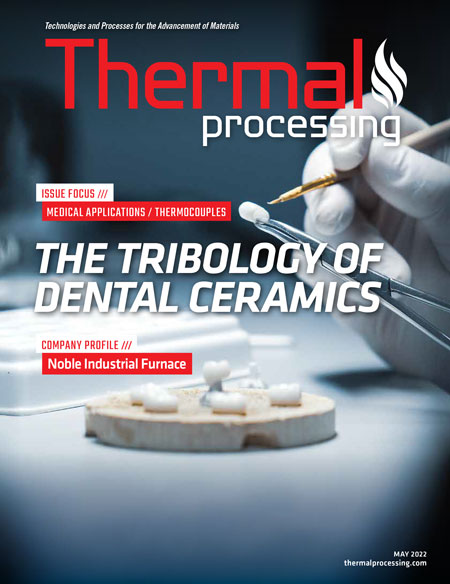
Quality is in the details, but what details need the most attention? A good contract review, starting with the purchase order, then the drawing, then the related customer specifications — whether they be material specifications or specific heat-treat specifications — is considered a good first step and is required for aerospace work. Those steps provide the rules for heat treating the parts and are important.
Companies also put in place work instructions and travelers to keep traceability and control the details of nonconformances and process details, also requirements and ways to maintain control for the process. However, along with these specific parameters it is equally important to understand the “why” from a theoretical metallurgical perspective.
Classroom training is important to realize that what is going on in the furnace is making some serious changes to the microstructure internally. Solution temperatures are designed to be in one phase regions on simple binary equilibrium phase diagrams, but selection of this setpoint must be careful to be above the solvus and below the solidus temperatures. Ramp rates are designed to eliminate chance for overshoot and/or thermal shock to not create any undesirable melting. The time at temperature provides the necessary time for the atoms to diffuse to their positions in the part for the properties needed. Atmospheres are reviewed for carburizing, nitriding, or even protection against vaporization and/or oxidation of elements at the surface of parts. Then design of the quench rate ensures that the certain microstructure is obtained after review of the TTT curve (time, temperature, transformation curves).
Cycle understanding
The old saying “measure twice and cut once” in the context of heat treat could be interpreted as “learn the theory and fact check twice” to ensure quality of the cycle being run. First, check customer requirements. Second, check theoretical considerations, then hit go!
Customer specifications tell the heat treater to take parts along the process to cook much as you would follow a recipe for cookies in your kitchen oven, so they come out at their best. The parts satisfy the customer’s requirements. However, anyone can press the temperature up and down buttons and start a timer and bake the cookies or even obtain the mechanical properties in a specific component that is housed in the combustible section of the jet engine. But the heat-treat operator is more than just a mechanized set of limbs pushing buttons and pulling loads.
The operator doesn’t need to defend a Ph.D. thesis on thermodynamic and kinetic principles of metallic alloy phenomena when performing a heat-treat cycle, but providing the knowledge and empowering them to know why they are making the furnace do what it needs to do is important to building a sense of belonging and ownership to the process. This promotes the overall quality of the process because the operator feels they are an integral component to what they might otherwise think of as just being a spoke in a wheel. Sometimes, employees who have offices forget that one of their roles is to support the employees who move the product along.
Having some understanding of theory helps in troubleshooting as well. When the power goes out and a load needs to be cooled, the first question should be “what happened to the microstructure?” rather than simply looking at the answer of what the customer requires. Knowing the “why” gives more clarity on what to do and hopefully the customer specification has taken the same approach.

Thermodynamic considerations
In thermodynamics, systems go from a state A to a state B under certain variables. So, operators take parts from A to B by loading, running the cycle, and unloading the parts to the next step. However, it’s important to educate them on what is actually going on in the microstructure from state A (e.g. as cast microstructure) to a state B (e.g. solution range allowing eutectic phases to dissolve into the matrix). Often this as-cast microstructure is not desirable for end use properties in service and heat treat is required to improve these properties for practical reasons, not just because the customer says to do it. From alloy segregation to controlled precipitation of particular phases that yield mechanical properties, heat treat with carefully designed times, temperatures, ramp rates, and even atmospheres achieve desirable properties from the material.
Studying simple binary phase diagrams provides the tools for the operators to recognize potential eutectic reactions and setup baskets and parts accordingly. The work becomes a form of play when the operator begins to learn the jargon and use it in their conversations around heat treat. Problem solving becomes easier as the engineer can now discuss the process and potential issues in the same language with the entire team.
Kinetic considerations
Helping operators know where the system goes beyond the customer’s requirements is only one aspect for training. Production is always concerned with how fast things can get produced on the floor, so studying the kinetic reactions within the part being heat-treated is beneficial for understanding the time it takes for the atoms to properly diffuse.
One example we recently used was solving the Arrhenius equation in determining the diffusivity of a particular solute atom from the interdendritic region to a secondary dendrite (distance was obtained from a micrograph) to then calculate diffusion time for the solution cycle.
Allowing the operators to see the equation and the math and the assumptions made with the calculation actually confirmed the time the customer had required in their specification. There was no way to speed up this particular process.
A term came up recently calling the heat-treat operators “pseudo-engineers.” In a way, there is some truth in that. They are not necessarily designing and developing the process, but as key components to the process they need to be adequately trained to understand the impact of heat-treat cycles on parts. But this does not make them fake engineers. If anything, they are making the entire train move forward. They actually heat treat the parts.
Again, those in offices who make decisions would do well to remember that every team benefits from having players who cooperate and respect each person’s role in the process.


























